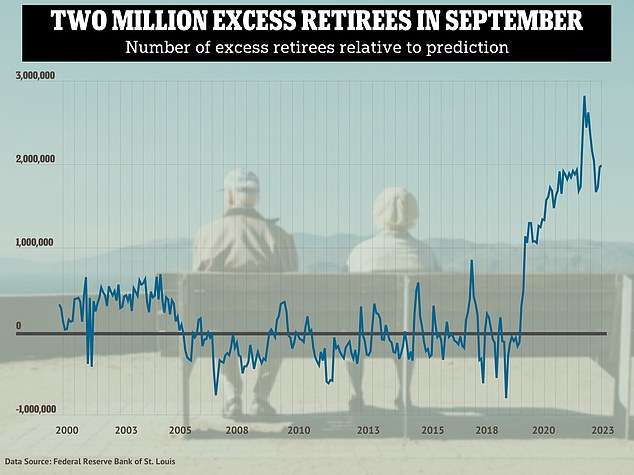The ‘Great Unretirement falls flat’: Over 2 million Americans who retired during the pandemic are not returning to work as predicted, study shows
- There are two million more retirees than predicted by the Federal Reserve
- A lack of re-employment of people over 65 could lead to low unemployment
- Did you retire during the pandemic? Send us an email at money@dailymail.com
After the pandemic caused a huge spike in the number of older workers prematurely leaving the workforce, many economists predicted there would be “high unemployment.”
But it seems they have been proven wrong. A model from the Federal Reserve Bank of St. Louis shows that there are still nearly two million more retirees than predicted.
There are still nearly two million more retirees than there should be, according to a Federal Reserve Bank of St. Louis model that shows these are mostly people over 65.
And while that gap started to narrow earlier this year, the latest data indicates that it is now actually widening again.
The number of retirees peaked at about 2.44 million in January and fell to about 1.67 million in June. But the latest Fed data for September shows the pension surplus rising again to about 1.98 million.
The actual share of the population that retired roughly followed the predicted share from January 2000 through February 2020, when there was a difference
Miguel Faria e Castro, economic policy advisor at the St. Louis Fed and maker of the modelsuggested that the continued inability of retirees to return to work could contribute to the tight labor market and low unemployment rate.
Since the pandemic, the Federal Reserve has embarked on a historic series of rate hikes in an effort to control inflation and minimize spending across the economy.
(item name = module id = 119913159 style = undefined /)
But despite interest rates of 5.25 to 5.5 percent – the highest in more than two decades – the labor market has remained strong. In September, the Fed’s pension data was added last month. The U.S. Bureau of Labor Statistics reported that the economy added 336,000 jobs, nearly double economists’ expectations.
Faria e Castro’s model uses working conditions, demographic information, and social security benefit information to calculate the pension amount that would be expected under “normal conditions.”
And the actual share of the population that retired roughly followed the predicted share from January 2000 through February 2020, until the substantial differences emerged.
Since the sudden emergence of the rift, there has been widespread speculation about the coming retirement. Asset manager T. Rowe Price noted this in his “Unretiring” report, published last month.

After peaking at about 2.44 million in January and falling to about 1.67 million in June, the latest Fed data for September indicates that excess pension has risen again to about 1.98 million

There are still nearly two million more retirees than there should be, according to a model from the Federal Reserve Bank of St. Louis
It found that about 20 percent of those who consider themselves retired actually work full- or part-time, and a further 7 percent are actively looking for work.
“While the gap appeared to be closing earlier this year, it appears to have widened slightly since then,” Faria e Castro told Bloomberg.
And the labor force participation rate (LFPR) for people 65 and older, as calculated by the Bureau of Labor Statistics, also indicates that participation is still well below pre-pandemic levels.
In October, participation was 23.7 percent. In January 2020, it had just peaked at 26.0 percent. While many view retirement as a one-way process, others are actively looking for new work.
